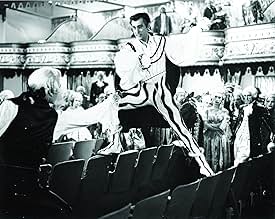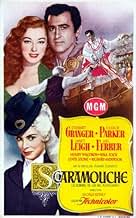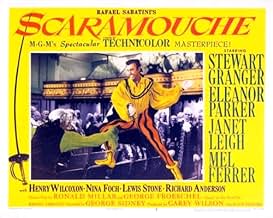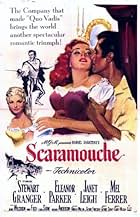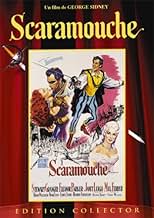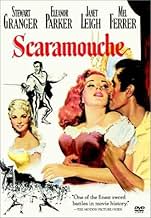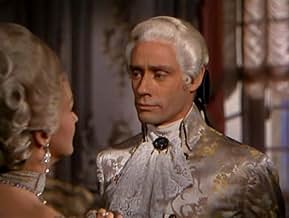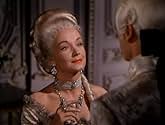IMDb-BEWERTUNG
7,5/10
6668
IHRE BEWERTUNG
Füge eine Handlung in deiner Sprache hinzuIn France during the late 18th Century, a man sets out to avenge the death of his friend at the hands of a master swordsman.In France during the late 18th Century, a man sets out to avenge the death of his friend at the hands of a master swordsman.In France during the late 18th Century, a man sets out to avenge the death of his friend at the hands of a master swordsman.
- Auszeichnungen
- 3 Nominierungen insgesamt
Empfohlene Bewertungen
An 18th century nobleman (Stewart Granger) avenging the death of a friend sets in motion the action-filled plot of this Rafael Sabatini tale filmed in gorgeous technicolor and done in rollicking tongue-in-cheek style by an able cast. Eleanor Parker and Janet Leigh both look beautiful as the women in love with Granger's character, who, to hide his true identity must wear the mask of an actor called Scaramouche. It's all done in high style with some beautifully filmed sets and costumes that are breathtaking in color.
Not for a moment can the improbable plot bear close scrutiny--nor is it intended to judging from the over-the-top performance of Stewart Granger in the kind of role that brought stardom to actors like Errol Flynn and Tyrone Power. Stewart Granger and Mel Ferrer are dueling opponents throughout, including the final seven minute duel that takes place in a crowded theater where the astonished audience is treated to one of the most skillful duels ever filmed.
The finale would have been even more impressive if the film hadn't already offered a number of extensive dueling scenes. Director George Sidney seems to relish the swashbuckling elements of the screenplay and gives too much time to the various duels without giving the characters too much dimension. Eleanor Parker is strikingly beautiful as the tempestuous actress constantly bickering with the athletic Granger, obviously relishing her colorful role. By contrast, Janet Leigh seems very demure indeed in a more conventional role.
Victor Young's colorful score is a decided asset, punctuating the proceedings with the required dash and eloquence. If swashbuckling romantic adventures are the kind of action films you admire, you'll have a grand time with this one. Grade A production values all the way and directed at a fast clip despite its two hour running time.
Not for a moment can the improbable plot bear close scrutiny--nor is it intended to judging from the over-the-top performance of Stewart Granger in the kind of role that brought stardom to actors like Errol Flynn and Tyrone Power. Stewart Granger and Mel Ferrer are dueling opponents throughout, including the final seven minute duel that takes place in a crowded theater where the astonished audience is treated to one of the most skillful duels ever filmed.
The finale would have been even more impressive if the film hadn't already offered a number of extensive dueling scenes. Director George Sidney seems to relish the swashbuckling elements of the screenplay and gives too much time to the various duels without giving the characters too much dimension. Eleanor Parker is strikingly beautiful as the tempestuous actress constantly bickering with the athletic Granger, obviously relishing her colorful role. By contrast, Janet Leigh seems very demure indeed in a more conventional role.
Victor Young's colorful score is a decided asset, punctuating the proceedings with the required dash and eloquence. If swashbuckling romantic adventures are the kind of action films you admire, you'll have a grand time with this one. Grade A production values all the way and directed at a fast clip despite its two hour running time.
The robust Stewart Granger is "Scaramouche" in this 1952 adaptation of the Sabatini novel, and it's a good example of the kind of film MGM excelled at - it's a fast-moving adventure in beautiful color, with great production values.
Granger plays Andre Moreau, who watches a friend killed in a sword fight with the Marquis (Mel Ferrer). Andre, alas, can't go after the Marquis - he can't handle a sword anywhere close enough. Instead, he joins a traveling company of actors and becomes "Scaramouche." He encounters romance, but he has plenty of time to learn how to use a sword. Finally, he and the Marquis meet again, in a long, exciting, swordfight that takes place in a theater, the highlight of the film.
Very exciting movie in spots, gorgeous to look at, with strong performances by the well-cast Granger, Mel Ferrer, and the beautiful Eleanor Parker. A rousing adventure - if you like swashbuckler movies, don't miss this one!
Granger plays Andre Moreau, who watches a friend killed in a sword fight with the Marquis (Mel Ferrer). Andre, alas, can't go after the Marquis - he can't handle a sword anywhere close enough. Instead, he joins a traveling company of actors and becomes "Scaramouche." He encounters romance, but he has plenty of time to learn how to use a sword. Finally, he and the Marquis meet again, in a long, exciting, swordfight that takes place in a theater, the highlight of the film.
Very exciting movie in spots, gorgeous to look at, with strong performances by the well-cast Granger, Mel Ferrer, and the beautiful Eleanor Parker. A rousing adventure - if you like swashbuckler movies, don't miss this one!
The Commedia dell'Arte is an old Italian form of stage presentation, dating from the 16th century and featuring a series of stock characters like Arlecchino, Pantolone, Pulchnello, and Capitano. Everyone in the audience knew their comic weaknesses and looked forward to seeing them on display, kind of like a John Ford movie. The characters were called zanni and played practical jokes on each other (called "burle", which gives us "burlesque.") As in this movie the humor was often improvised. When the form was taken to France, Arlecchino became Harlequin, Pantalone became Pantaloon (from which we get our "pants"), Pulchinello morphed into Punch, and Capitano, a character who was a braggart soldier, was changed to Scaramouche and became an admired acrobatic mime, which suited French tastes. Sorry for the tedious introduction but it helps to get the interesting history out of the way fast.
The rest of the movie is a comic book and, like a comic book, filled with colorful people in comic-book costumes, zestful and exuberant. If you want a movie to have zip, one way of doing it is to have lots of people riding horses. But the horses should always be ridden at a gallop, and with slightly accelerated motion. (The gallops were shot partly in Golden Gate Park.) Another way of adding action is to have the lovers fight each other physically, as in "Taming of the Shrew", instead of wistfully melting into each others' arms at every meeting and parting. A third way is to build the main plot around a few well-choreographed action scenes -- and in this respect the movie is superb.
"Scaramouche" reminds one of Errol Flynn at his best, in "The Adventures of Robin Hood." Instead of Saxons and Normans, we have aristocrats and poor people. (Fortunately the Saxons in "Robin Hood" didn't win a revolution and implement a reign of terror.) The aristocrats dress in outrageously ornate costumes. The poor people are in dark clothes, like the figure on the Quaker Oats package.
There's quite a lot of fencing but much of it is brief and in long shot. There are three main encounters between Stewart Granger and his nemesis Mel Ferrer. Granger is manly and well built and forceful in his style. Ferrer is long-limbed and lanky, deceptively clumsy at times, but he has never given a more graceful physical performance.
In the first match between the two, Granger knows nothing about the sword and hacks away at Ferrer, who stands there nonchalantly, smiling, leaning on his weapon as if it were a walking stick between easy parries. In the second, Granger has picked up a few tricks but is still easily outmatched and has to escape through one of those secret doors in a paneled wall. The third match is more than six minutes long and is as well staged as any duel on screen -- better than anything in "Robin Hood" and at least as good as "The Mark of Zorro." Granger swings off the stage on a rope to confront Ferrer who is in the theater balcony. And you should see Stewart's wardrobe in this scene! Unbelievable skin-tight leotards, white boots with furry tops, a white cape -- everything -- mostly white with black accents. Ferrer strips off his jacket and is dressed in black shoes and stockings, black pants, black vest, and a white blouse with ruffles, mostly black, that is. (I warned you this was a comic book.) The ensuing duel wanders all over the theater while the spectators tumble out of the actors' way. Note the scene where the advantage changes from Ferrer to Granger when the fight moves from the bottom of the stairs to the rows of theater seats. Ferrer does an almost impossible balletic leap from one row to the next, twirling around in midair. (Another footnote: original ballet steps borrowed heavily from contemporary fencing movements. Sorry.)
The movie has its sad moments too, and the plot is a bit complicated although never hard to follow. But its overall tonus is comedic, as befits Scaramouche's venue. Granger may not be Errol Flynn but he's pretty good, and a better actor. The two women in his life are adequate, but Janet Leigh was a beginner and it shows. She was to be better in some later movies like "Psycho." She looks like a porcelain doll in some shots. The supporting players are all professionally competent.
It's an entertaining and well-crafted piece of entertainment -- exciting and vibrant with color. A comic book worth checking out.
The rest of the movie is a comic book and, like a comic book, filled with colorful people in comic-book costumes, zestful and exuberant. If you want a movie to have zip, one way of doing it is to have lots of people riding horses. But the horses should always be ridden at a gallop, and with slightly accelerated motion. (The gallops were shot partly in Golden Gate Park.) Another way of adding action is to have the lovers fight each other physically, as in "Taming of the Shrew", instead of wistfully melting into each others' arms at every meeting and parting. A third way is to build the main plot around a few well-choreographed action scenes -- and in this respect the movie is superb.
"Scaramouche" reminds one of Errol Flynn at his best, in "The Adventures of Robin Hood." Instead of Saxons and Normans, we have aristocrats and poor people. (Fortunately the Saxons in "Robin Hood" didn't win a revolution and implement a reign of terror.) The aristocrats dress in outrageously ornate costumes. The poor people are in dark clothes, like the figure on the Quaker Oats package.
There's quite a lot of fencing but much of it is brief and in long shot. There are three main encounters between Stewart Granger and his nemesis Mel Ferrer. Granger is manly and well built and forceful in his style. Ferrer is long-limbed and lanky, deceptively clumsy at times, but he has never given a more graceful physical performance.
In the first match between the two, Granger knows nothing about the sword and hacks away at Ferrer, who stands there nonchalantly, smiling, leaning on his weapon as if it were a walking stick between easy parries. In the second, Granger has picked up a few tricks but is still easily outmatched and has to escape through one of those secret doors in a paneled wall. The third match is more than six minutes long and is as well staged as any duel on screen -- better than anything in "Robin Hood" and at least as good as "The Mark of Zorro." Granger swings off the stage on a rope to confront Ferrer who is in the theater balcony. And you should see Stewart's wardrobe in this scene! Unbelievable skin-tight leotards, white boots with furry tops, a white cape -- everything -- mostly white with black accents. Ferrer strips off his jacket and is dressed in black shoes and stockings, black pants, black vest, and a white blouse with ruffles, mostly black, that is. (I warned you this was a comic book.) The ensuing duel wanders all over the theater while the spectators tumble out of the actors' way. Note the scene where the advantage changes from Ferrer to Granger when the fight moves from the bottom of the stairs to the rows of theater seats. Ferrer does an almost impossible balletic leap from one row to the next, twirling around in midair. (Another footnote: original ballet steps borrowed heavily from contemporary fencing movements. Sorry.)
The movie has its sad moments too, and the plot is a bit complicated although never hard to follow. But its overall tonus is comedic, as befits Scaramouche's venue. Granger may not be Errol Flynn but he's pretty good, and a better actor. The two women in his life are adequate, but Janet Leigh was a beginner and it shows. She was to be better in some later movies like "Psycho." She looks like a porcelain doll in some shots. The supporting players are all professionally competent.
It's an entertaining and well-crafted piece of entertainment -- exciting and vibrant with color. A comic book worth checking out.
As has been commented by the other two people, the final sword fight makes the movie (although it is not the only reason to watch). It runs non-stop for over 7 minutes. One interesting point is that aside from the leap from the staircase to the floor below, Granger did all of his own stunts in the sequence (including swinging from the stage into the opera box and dangling over the audience early in the fight). The only fight that comes anywhere near it is the one between Danny Kaye and Basel Rathbone in "Court Jester".
This is a movie milestone in my life.
I have chosen this handle and this film to be my first review on this site because it was the very first film I ever watched.
However my enjoyment was limited due to the fact that I was five days old at the time. This resulted in a rather poor grasp of the plot and an overall lack of excitement from beginning to end. The story goes that the day my twin brother and I were taken home from hospital after our birth, Scaramouche was the evening film on the BBC and we were given our baths completely oblivious to the movie gem we were being treated to on our first night in our new home.
I personally do not remember this but I have been reliably informed that this is so.
Over the years however, I have acquired a great passion for the films of the golden age and Scaramouche, although not the best of films, is definitely a classic.
Stewart Granger plays Andre Moroe a free spirit, who's life has amounted to nothing more than his constant pursuit of fun and wealthy ladies in 17th Century France. However the murder of his closest friend, a revolutionist in the making, turns him into a man driven by revenge. However there is one tiny drawback as the man on whom he seeks vengeance is the best swordsman in France and Andre has never held a sword in his life. But he is determined to learn it's ways in order to meter out his terrible revenge.
Immediately taking up lessons he wastes no time in becoming an expert fencer........about half an hour in fact.
This however is for me the most entertaining part of the film as the student out-fences the teachers in a series of montage images. It also contains one of the best uses of the English Language I have ever seen on film....or maybe I'm just easily pleased.
'if i can no longer be taught by the man who taught my enemy, then what is more fitting in a mad world,than to be taught by the man who taught the man who taught my enemy' Catchy eh?
However all this time Moroe is evading the villain's men by hiding out in a circus of sorts where he has adopted the role of the masked Scaramouche.....the clown.
It is at one of his performances where Moroe comes face to face with his friends killer and in true Hollywood fashion, they duel in and out of the shocked spectators hanging over perilous ledges and high theatre balconies and of course up and down grand staircases.
Mel Ferrer is wonderful as the evil Demain and gives his role an almost Bond villain presence with his charm ans sophistication, and for love interest we have both Eleanor Parker and Janet Leigh (before she started taking showers) Yet for once Hollywood decided to put romance on the back burner and these two beauties, although great in the roles, have nothing more to do than parade around in cleavage inducing bodices, although that's fine with me. If this film is your cup of tea or not, it's worth watching for that alone.
There are other aspects of the plot which I need not go into here except that they amount to the "he was my father which makes you my sister" scenario and when the unknown brother is revealed, you will be forgiven in thinking you had tuned into a period edition of EastEnders but despite all this is definitely worth the watch.
Incidentally the final sword fight was the longest sword fight in movie history until Antonio Banderas and Catherine Zeta Jones fenced their way into the record books in The Mask of Zorro. They may now have the longest but Scaramouche still has the best.
I have chosen this handle and this film to be my first review on this site because it was the very first film I ever watched.
However my enjoyment was limited due to the fact that I was five days old at the time. This resulted in a rather poor grasp of the plot and an overall lack of excitement from beginning to end. The story goes that the day my twin brother and I were taken home from hospital after our birth, Scaramouche was the evening film on the BBC and we were given our baths completely oblivious to the movie gem we were being treated to on our first night in our new home.
I personally do not remember this but I have been reliably informed that this is so.
Over the years however, I have acquired a great passion for the films of the golden age and Scaramouche, although not the best of films, is definitely a classic.
Stewart Granger plays Andre Moroe a free spirit, who's life has amounted to nothing more than his constant pursuit of fun and wealthy ladies in 17th Century France. However the murder of his closest friend, a revolutionist in the making, turns him into a man driven by revenge. However there is one tiny drawback as the man on whom he seeks vengeance is the best swordsman in France and Andre has never held a sword in his life. But he is determined to learn it's ways in order to meter out his terrible revenge.
Immediately taking up lessons he wastes no time in becoming an expert fencer........about half an hour in fact.
This however is for me the most entertaining part of the film as the student out-fences the teachers in a series of montage images. It also contains one of the best uses of the English Language I have ever seen on film....or maybe I'm just easily pleased.
'if i can no longer be taught by the man who taught my enemy, then what is more fitting in a mad world,than to be taught by the man who taught the man who taught my enemy' Catchy eh?
However all this time Moroe is evading the villain's men by hiding out in a circus of sorts where he has adopted the role of the masked Scaramouche.....the clown.
It is at one of his performances where Moroe comes face to face with his friends killer and in true Hollywood fashion, they duel in and out of the shocked spectators hanging over perilous ledges and high theatre balconies and of course up and down grand staircases.
Mel Ferrer is wonderful as the evil Demain and gives his role an almost Bond villain presence with his charm ans sophistication, and for love interest we have both Eleanor Parker and Janet Leigh (before she started taking showers) Yet for once Hollywood decided to put romance on the back burner and these two beauties, although great in the roles, have nothing more to do than parade around in cleavage inducing bodices, although that's fine with me. If this film is your cup of tea or not, it's worth watching for that alone.
There are other aspects of the plot which I need not go into here except that they amount to the "he was my father which makes you my sister" scenario and when the unknown brother is revealed, you will be forgiven in thinking you had tuned into a period edition of EastEnders but despite all this is definitely worth the watch.
Incidentally the final sword fight was the longest sword fight in movie history until Antonio Banderas and Catherine Zeta Jones fenced their way into the record books in The Mask of Zorro. They may now have the longest but Scaramouche still has the best.
Wusstest du schon
- WissenswertesScaramouche is a roguish, burlesque clown who originated as a stock character in the 17th century Italian commedia dell'arte, where he was known as "Scaramuccia," which literally means "skirmish." He wears a black mask with a large nose who broadly grimaces and indulges in slapstick behavior and is generally beaten by Harlequin for his boasting and cowardice. He is an traditionally iconic character found in Punch and Judy shows.
- PatzerThe soldiers wear uniforms from the Napoleonic era, not the pre-Revolution period.
- Zitate
Andre Moreau: You may turn your back on Scaramouche, my lord, but surely you will not run away from Andre Moreau?
Noel, Marquis de Maynes: Scaramouche, you have just given your last performance.
[they fight]
- VerbindungenFeatured in Precious Images (1986)
Top-Auswahl
Melde dich zum Bewerten an und greife auf die Watchlist für personalisierte Empfehlungen zu.
- How long is Scaramouche?Powered by Alexa
- Is "Scaramouche" based on a book?
- Was Scaramouche a real person?
Details
Box Office
- Budget
- 3.500.000 $ (geschätzt)
- Laufzeit1 Stunde 55 Minuten
- Seitenverhältnis
- 1.33 : 1
Zu dieser Seite beitragen
Bearbeitung vorschlagen oder fehlenden Inhalt hinzufügen

Oberste Lücke
By what name was Scaramouche - Der Mann mit der Maske (1952) officially released in India in English?
Antwort

